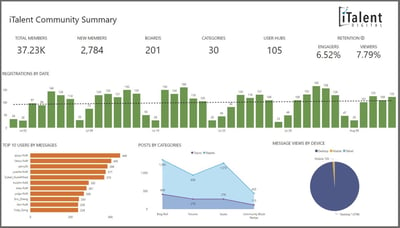The best technology for optimizing business intelligence

What is the best technology for gaining even better intelligence from the massive amounts of data a typical company acquires?
Being better than competitors at mining and understanding customer data is the enterprise holy grail. The business intelligence (BI) software market is projected to top US$27 billion this year (2024).
But what technology should be used and how should enterprises prioritize BI initiatives?
In my experience, there isn’t one technology or platform that would work for everyone. One of the biggest mistakes I’ve seen is for companies to invest in a promising technology without first getting a clear understanding of their customers, their buying journeys, and how that translates into the data landscape.
The most dramatic improvements in operational efficiency and BI excellence are derived from a tailored, prescriptive approach based on the unique characteristics and needs of a particular company’s customers.
Using tech to drive more meaningful customer interactions
An example of how powerful this approach can be is a client we had in the data storage space. It used to literally take them weeks to be able to pull reports from different data sources to get a sense of sales, or of contract information, or of subscription usage, or customer satisfaction gleaned from customer support experiences. We were able to automate all of this and take reporting time from weeks to days.
weeks to days.
To get a sense of how significant this is, imagine a sales executive pulling up to a client site and having on their phone what we call a Customer 360º Dashboard: a one-stop shop that tells them about what the customer has purchased, subscription information, consumption (how much) of what they're using today, and so forth.
Furthermore, the tool can layer in information around customer experience, such as how they called and engaged with the customer support team for issues within a given time frame.
As a result, for his meeting with the customer, the sales executive has a much better sense of what the upsell and cross-sell opportunities are. He understands the status of the account in terms of green, yellow, red – is the relationship at a point where they need all hands on deck (red) or are things going well (green)? He has the information he needs at his fingertips to be able to drive a more relevant and productive conversation with his customer.
Case study: Read more about how we automated business reporting and delivered a 360º customer dashboard for this enterprise customer
Using tech to drive operational excellence
This prescriptive approach has allowed us to drive operational excellence and productivity for a wide range of enterprise customers. In a nutshell, operational excellence means working smarter, not harder. And it also means identifying areas of opportunity for process optimization, especially through automation and other forms of digital transformation.
And, what technologies have we been using to do that? Again, it depends. We place an importance on being technology-agnostic for this very reason; we need to first understand the customer to deliver tailored solutions.
Sometimes, we find that the perfect solution doesn’t exist, so we need to build one. This is why we have a full-service DevOps team to support our deployments.
Customizing tech to spec
One area that has benefitted greatly from a customized solution is change management. Change management is a good example of a discipline that has traditionally been characterized by manual processes. iTalent built an AI-enabled software called ChaMa that digitizes and automates change management workflows.
One client was able to reduce the amount of time that they were spending mining data and putting together presentations by 90%. The time it took them to report on their change projects went from several days to just 30 minutes!
And the real benefit was not just in the time savings; it allowed them to tailor the data story for each individual stakeholder on demand, which means they had more relevant conversations with them and experienced much better buy-in and adoption. Before using ChaMa, every time someone had a special request or asked a question that was not in the presentation they had manually generated, another 8 hours on average was spent going back and mining the data to get them the information they needed. Now, it can be pulled up on the spot with the click of a computer mouse.
Case study: Read about how our customer slashed program report generation time by 90%
Another example of a custom solution we built was for Microsoft. It wanted to glean better intelligence from the activity in its Power BI online support community. iTalent Digital created an intelligent solution that receives detailed information about content, engagement, problem resolution, and customer activity from their online community and combines it with data from a multitude of additional sources such as sales and marketing. This enables Microsoft to analyze and scrutinize, to a very high level of granularity, the operation and success of these immense digital communities, which in turn helps Microsoft manage its Power BI business more efficiently.
intelligence from the activity in its Power BI online support community. iTalent Digital created an intelligent solution that receives detailed information about content, engagement, problem resolution, and customer activity from their online community and combines it with data from a multitude of additional sources such as sales and marketing. This enables Microsoft to analyze and scrutinize, to a very high level of granularity, the operation and success of these immense digital communities, which in turn helps Microsoft manage its Power BI business more efficiently.
Case study: Read about how we helped Microsoft amplify their Power BI customer insights
Don’t forget the training
I’ve mentioned that a common mistake is investing in technology before getting a good handle on the customer and the data landscape. Another area of opportunity I see is in training. A company may find a solution that has all of the features they want and need, but if its people are not properly trained to use it, it will be very difficult to derive value from the investment.
Giving training and the people side of technology its due importance will optimize the returns on technology investments and help companies excel from a business intelligence perspective.
Watch the video
Check out this 5-minute video where my colleagues and I share some insights on achieving operational excellence through business intelligence.
Final thoughts
Leaders need to make decisions quickly. To do so, they need the right data readily accessible to be able to answer whatever questions they have in the moment so they can make that decision, move on quickly, and better allocate their people, their resources and their time. Good use of the right technology and guidance enables and accelerates this.
Would you like to up your business intelligence game? Contact us at itbi@italentdigital.com to speak with us about your needs, or visit our BI, Data & Analytics Practice page for more information.
You may also like:
The five levels of data visualization and reporting maturity – how does your organization stack up?
What is a chief data and analytics officer, and why do you need one?
Migrating to Microsoft Azure? Here’s what you need to consider



